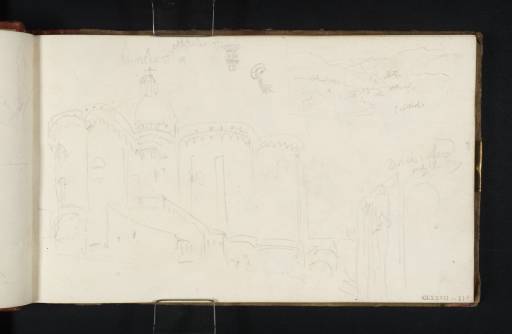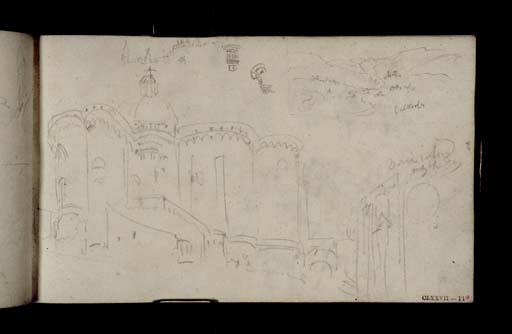Joseph Mallord William Turner The Santuario della Santa Casa, Loreto, from Porta Marina; and a Distant View of Caldarola 1819
Image 1 of 2
Joseph Mallord William Turner,
The Santuario della Santa Casa, Loreto, from Porta Marina; and a Distant View of Caldarola
1819
Joseph Mallord William Turner 1775–1851
Folio 11 Recto:
The Santuario della Santa Casa, Loreto, from Porta Marina; and a Distant View of Caldarola 1819
D14673
Turner Bequest CLXXVII 11
Turner Bequest CLXXVII 11
Pencil on white wove paper, 110 x 186 mm
Inscribed by the artist in pencil ‘Calterola’ within sketch of mountains top right and ‘Doric columns | [...] the [...]’ centre of right-hand edge
Inscribed by John Ruskin in red ink ‘11’ bottom right
Stamped in black ‘CLXXVII 11’ bottom right
Inscribed by the artist in pencil ‘Calterola’ within sketch of mountains top right and ‘Doric columns | [...] the [...]’ centre of right-hand edge
Inscribed by John Ruskin in red ink ‘11’ bottom right
Stamped in black ‘CLXXVII 11’ bottom right
Accepted by the nation as part of the Turner Bequest 1856
References
1909
A.J. Finberg, A Complete Inventory of the Drawings of the Turner Bequest, London 1909, vol.I, p.521 as ‘Building, “Doric, &c.” (Chiesa della Casa Santa, Loreto); also view of “Caldarolo” ’.
1982
Evelyn Joll and Martin Butlin, L’opera completa di Turner 1793–1829, Classici dell’arte, Milan 1982, p.[120] under no.331.
1984
Martin Butlin and Evelyn Joll, The Paintings of J.M.W. Turner, revised ed., New Haven and London 1984, p.185 under no.331.
1984
Cecilia Powell, ‘Turner on Classic Ground: His Visits to Central and Southern Italy and Related Paintings and Drawings’, unpublished Ph.D thesis, Courtauld Institute of Art, University of London 1984, pp.98, 408, 467 note 125, as ‘The Santuario della Santa Casa, Loreto’.
1987
Cecilia Powell, Turner in the South: Rome, Naples, Florence, New Haven and London 1987, p.31 note 56.
2008
Nicola Moorby, ‘Un tesoro italiano: i taccuini di Turner’, in James Hamilton, Nicola Moorby, Christopher Baker and others, Turner e l’Italia, exhibition catalogue, Palazzo dei Diamanti, Ferrara 2008, pp.98, 105 note 8.
2009
Nicola Moorby, ‘An Italian Treasury: Turner’s sketchbooks’, in James Hamilton, Nicola Moorby, Christopher Baker and others, Turner & Italy, exhibition catalogue, National Galleries of Scotland, Edinburgh 2009, pp.111, 154 note 9.
The first significant place of interest on the route to Rome after Ancona was Loreto, a small city approximately fourteen miles to the south. In addition to offering impressive panoramic views of the surrounding countryside, Loreto was famous for its basilica, the Santuario della Santa Casa, a popular site for Catholic pilgrimage. Enshrined within the church is a small stone building, believed to be the Holy House, the home of the Virgin Mary where she received the annunciation and where Jesus spent his childhood. According to legend, the house was transported from Palestine during the thirteenth century by a host of angels and eventually carried to its present site where it came to rest amidst the laurel woods which give Loreto its name. Turner made a number of sketches in and around the city, see folio 10 (D14671).
This drawing shows the view from the Porta Marina, the gate on the south-eastern side of Loreto which leads to the Piazzale Lotto and the back of the Santuario della Santa Casa. Built between 1469 and 1557 the late Gothic style of the basilica, with its distinctive round apses topped by machicolated walls, combines ecclesiastical architecture with military-like fortifications. The dome of the church, surmounted by an octagonal cupola, is the third largest in Italy. In addition to capturing the outline of the building, Turner has also recorded some of the architectural details separately; at the top are a couple of corbels, whilst in the bottom right-hand corner is a loose sketch of part of an exterior wall with the round window and Doric pilaster.
Additionally in the top right-hand corner of this page is a distant view of Calderola, a small town in the Apennines nearly thirty miles south-west from Loreto. Turner often used odd corners and spaces within his sketchbooks when he was in a hurry to capture passing landscapes from moving vehicles on the road. Also at the top he has drawn a more distinct profile sketch of Calderola’s buildings including the churches and the Rocca (castle).
Nicola Moorby
November 2008
How to cite
Nicola Moorby, ‘The Santuario della Santa Casa, Loreto, from Porta Marina; and a Distant View of Caldarola 1819 by Joseph Mallord William Turner’, catalogue entry, November 2008, in David Blayney Brown (ed.), J.M.W. Turner: Sketchbooks, Drawings and Watercolours, Tate Research Publication, December 2012, https://www


